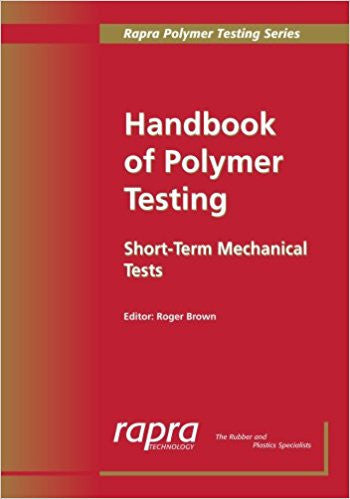Each class of materials has its own specific test procedures, which have developed as the material has evolved. This book concentrates on one area of testing – short-term mechanical tests. These are defined as tests of mechanical properties where the effects of long periods of time and cycling are ignored. This group of tests includes hardness, tensile, compression, shear, flexing, impact, and tear and in this book, it is also taken to include density and dimensional measurement together with test piece preparation and conditioning.
The topics covered in this book, include:
1. Introduction
Reasons for Testing, Source, and Condition of Test Pieces, Test Conditions, Limitations of Results, Sampling, Standards, Quality Control of Testing, Test Equipment, Product Testing, and Modes of Stressing.
2. Test Piece Preparation
Mixing, Moulding, Stamping from Sheet or Film, and Machining.
3. Conditioning
Storage, Conditioning, Heat Treatment, Mechanical Conditioning, Test Conditions, and Apparatus for Conditioning.
4. Mass, Density, and Dimensions
Measurement of Mass, of Density, and of Dimensions.
5. Hardness
Relationships, Standard Methods, and Other Methods.
6. Tensile Stress-Strain
General, and Test Methods.
7. Compression Stress-Strain
Test Apparatus, Standard, and Other Tests.
8. Shear Properties
Standard, and Other Tests.
9. Flexural Stress-Strain
General, and Test Methods.
10. Impact Strength
General, and Specific Tests.
11. Tear Properties
Test Piece Geometry, Standard, and Other Tests
12. Fracture Toughness
Standard, and Other Methods.
This book will be useful to all those who are already involved in the testing of polymers and it is an ideal guide to those just starting out in the field, whether in academia or industry.
1 Introduction
1.1 Scope
1.2 Reasons for Testing
1.3 Source and Condition of Test Pieces
1.3 Test Conditions
1.4 Limitations of Results
1.6 Sampling
1.7 Standards
1.8 Quality Control of Testing 1.9 Test Equipment
1.10 Product Testing
1.11 Modes of Stressing References
2 Test Piece Preparation
2.1 Introduction
2.2 Mixing
2.3 Moulding
2.4 Stamping from Sheet or Film
2.5 Machining References
3 Conditioning
3.1 Introduction
3.2 Storage
3.3 Conditioning
3.4 Heat Treatment 3.5 Mechanical Conditioning
3.5.1 Test Conditions
3.6 Apparatus for Conditioning
3.6.1 Air-Conditioned Rooms
3.6.2 Enclosures
3.6.3 Hygrometers
3.6.4 Thermometers
3.6.5 Apparatus for Elevated and Sub-Ambient Temperature References Appendix A – Tables of Thermal Equilibrium Times
4 Mass, Density, and Dimensions
4.1 Introduction
4.2 Measurement of Mass
4.3 Measurement of Density
4.4 Measurement of Dimensions
4.4.1 General
4.4.2 ‘Standard’ Laboratory Procedures
4.4.3 Other Procedures
4.4.4 Surface Roughness
4.4.5 Extensometry
4.4.6 Dimensional Stability
4.4.7 Dispersion References
5 Hardness
5.1 Introduction
5.2 Relationships
5.3 Standard Methods
5.3.1 Shore Durometer
5.3.2 Ball Indentation
5.3.3 Rockwell
5.3.4 Softness 5.3.5 Barcol Hardness
5.4 Other Methods References
6 Tensile Stress-Strain
6.1 General Considerations
6.1.1 Tough Materials with a Yield Stress Greater than the Failure Stress
6.1.2 Tough Materials with a Yield Stress Lower than the Failure Stress
6.1.3 Tough Materials with the same Yield and Failure Stress
6.1.4 Brittle Materials
6.2 Test Methods
6.2.1 Standard Methods
6.2.2 Test Apparatus
6.2.3 Test Pieces
6.2.4 Procedure References
7 Compression Stress-Strain
7.1 Introduction
7.2 Test Apparatus
7.3 Standard Tests
7.3 Other Tests References
8 Shear Properties
8.1 Introduction
8.2 Standard Tests
8.3 Other Tests References
9 Flexural Stress-Strain
9.1 General Considerations
9.2 Test Methods
9.2.1 Standard Methods
9.2.2 Test Apparatus
9.2.3 Test Pieces
9.2.4 Procedure References
10 Impact Strength
10.1 General Considerations
10.1.1 Introduction
10.1.2 Modes of Failure
10.1.3 Factors Affecting the Impact Strength
10.2 Specific Tests
10.2.1 Pendulum Methods
10.2.2 Drop Methods References
11 Tear Properties
11.1 Introduction
11.2 Test Piece Geometry
11.3 Standard Tests
11.4 Other Tests References
12 Fracture Toughness
12.1 Introduction
12.2 Standard Methods
12.3 Other Methods References




